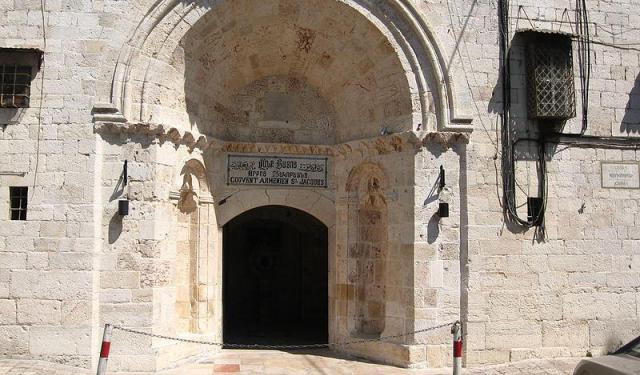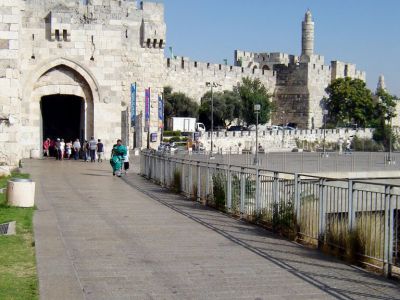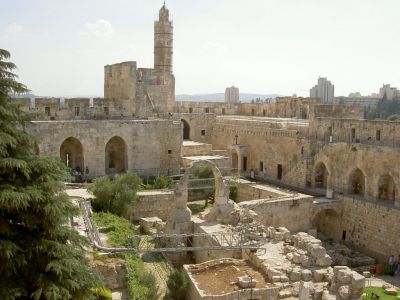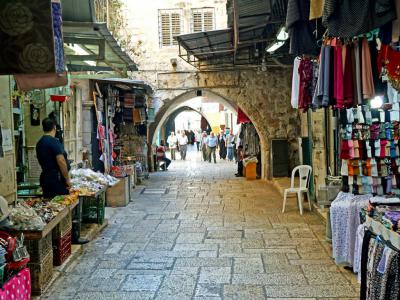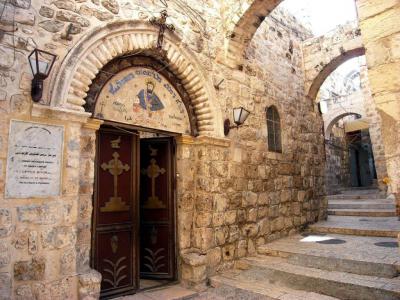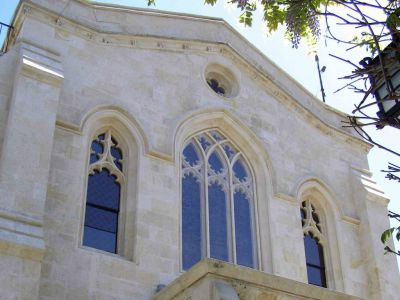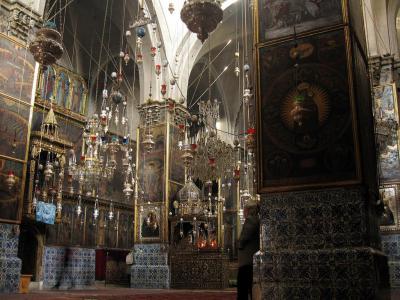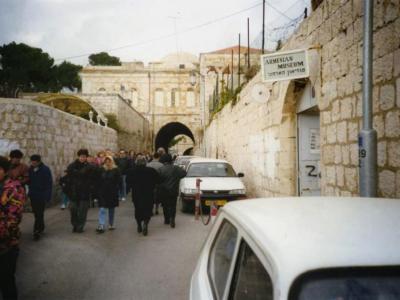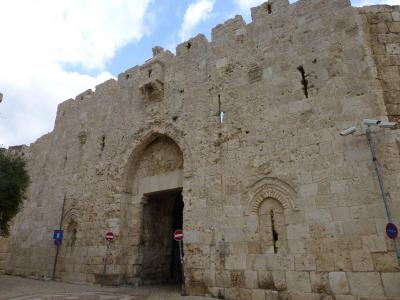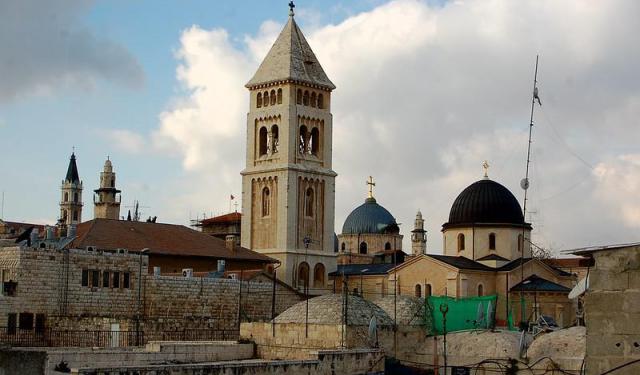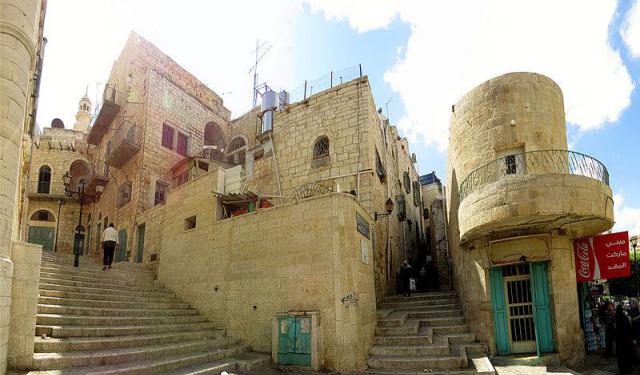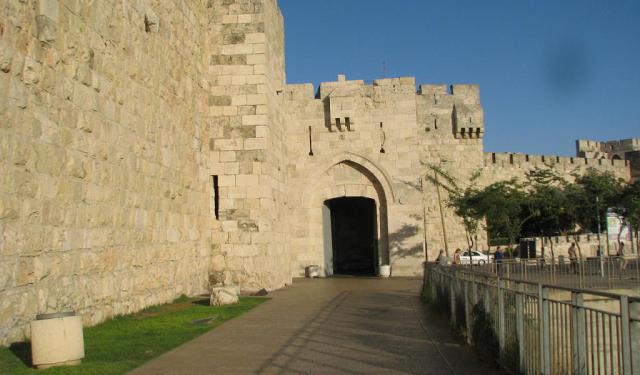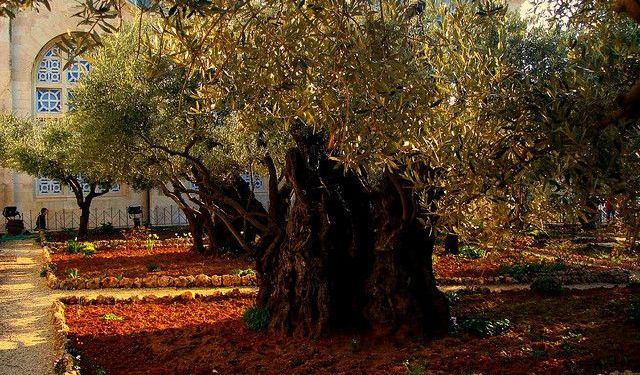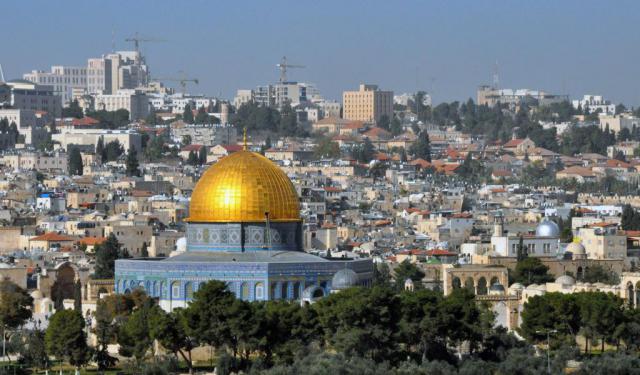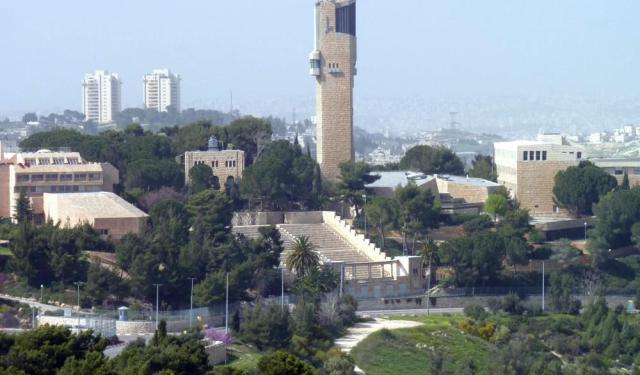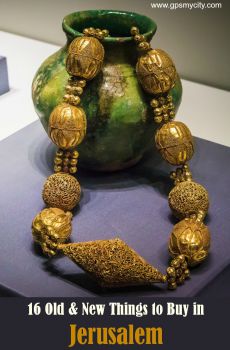Armenian Quarter Walking Tour (Self Guided), Jerusalem
Smaller and quieter than the Old City's other three quarters, the Armenian quarter contains a series of winding cobblestoned streets and alleyways teeming with people, shops, coffee stands, ceramic workshops and hookah bars. A city in miniature with distinct language, alphabet and culture, it has been in place since the 4th century, when Armenia adopted Christianity as a national religion.
Accessible through the Jaffa and Zion gates, its star attractions include the Tower of David – one of the city’s most interesting historic sights, home to a spectacular sound and light show in the evening; the captivating St. James Cathedral and its amazing choir; and what is considered to be the first church after Jesus’s resurrection – St Mark’s. At the quarter’s southern end, the Zion Gate, built by Suleiman the Magnificent’s engineers, provides access to neighboring Mount Zion.
In between these sights, make sure to stop by the open Arabic bazaar at David Street, the elegant Neo-Gothic Christ Church (oldest Protestant building in the Middle East!), and the Armenian Museum, whose most powerful exhibit depicts the nation’s genocide in Turkey during World War I.
As with the other quarters, a visit to the Armenian quarter is a must, so take this self-guided tour to walk your way through!
Accessible through the Jaffa and Zion gates, its star attractions include the Tower of David – one of the city’s most interesting historic sights, home to a spectacular sound and light show in the evening; the captivating St. James Cathedral and its amazing choir; and what is considered to be the first church after Jesus’s resurrection – St Mark’s. At the quarter’s southern end, the Zion Gate, built by Suleiman the Magnificent’s engineers, provides access to neighboring Mount Zion.
In between these sights, make sure to stop by the open Arabic bazaar at David Street, the elegant Neo-Gothic Christ Church (oldest Protestant building in the Middle East!), and the Armenian Museum, whose most powerful exhibit depicts the nation’s genocide in Turkey during World War I.
As with the other quarters, a visit to the Armenian quarter is a must, so take this self-guided tour to walk your way through!
How it works: Download the app "GPSmyCity: Walks in 1K+ Cities" from Apple App Store or Google Play Store to your mobile phone or tablet. The app turns your mobile device into a personal tour guide and its built-in GPS navigation functions guide you from one tour stop to next. The app works offline, so no data plan is needed when traveling abroad.
Armenian Quarter Walking Tour Map
Guide Name: Armenian Quarter Walking Tour
Guide Location: Israel » Jerusalem (See other walking tours in Jerusalem)
Guide Type: Self-guided Walking Tour (Sightseeing)
# of Attractions: 8
Tour Duration: 1 Hour(s)
Travel Distance: 1.2 Km or 0.7 Miles
Author: vickyc
Sight(s) Featured in This Guide:
Guide Location: Israel » Jerusalem (See other walking tours in Jerusalem)
Guide Type: Self-guided Walking Tour (Sightseeing)
# of Attractions: 8
Tour Duration: 1 Hour(s)
Travel Distance: 1.2 Km or 0.7 Miles
Author: vickyc
Sight(s) Featured in This Guide:
- Jaffa Gate
- The Citadel (Tower of David)
- David Street Arab Market (Shuk)
- Syrian Orthodox Convent and Church
- Christ Church
- Cathedral of St. James
- Armenian Museum
- Zion Gate
1) Jaffa Gate
The busiest among the seven gates of the Old City, this serves as the primary entrance for both traffic and pedestrians arriving from modern West Jerusalem via Mamilla. Despite its substantial size, the entrance tunnel is narrow and L-shaped, intentionally designed to impede the progress of attackers. Constructed during the reign of Suleyman the Magnificent, a dedication within the arch on the outside of the gate indicates the exact date of 1538.
Cars can access the Old City through this gate, a privilege attributed to Kaiser Wilhelm II's visit in 1898. Legend has it that the Ottoman authorities, mindful of the belief that every conqueror of the city must enter through here, created a breach in the wall between the gate and the Citadel. This allowed the Kaiser and his entourage to enter through the breach instead of the gate itself, which is on the north side of the breach. However, when General Edmund Allenby captured Jerusalem for the British in 1917, he famously declined to use the Kaiser's breach, opting instead to dismount along with his retinue and enter on foot through the gate, as a sign of respect to the city.
Known as Sha'ar Yafo in Hebrew and Bab al-Khalil in Arabic, the gate offers access to the ramparts, allowing visitors to walk along the city walls. Its various names reflect the diverse perspectives of Jerusalem's inhabitants: the English and Hebrew names allude to the ancient port city of Jaffa on the Mediterranean coast, known as an embarkation point for immigrants, pilgrims, and early tourists, while the Arabic name originates from the holy town of Hebron ("Al-Khalil"), signifying the old road leading to Hebron that commenced at this spot.
Cars can access the Old City through this gate, a privilege attributed to Kaiser Wilhelm II's visit in 1898. Legend has it that the Ottoman authorities, mindful of the belief that every conqueror of the city must enter through here, created a breach in the wall between the gate and the Citadel. This allowed the Kaiser and his entourage to enter through the breach instead of the gate itself, which is on the north side of the breach. However, when General Edmund Allenby captured Jerusalem for the British in 1917, he famously declined to use the Kaiser's breach, opting instead to dismount along with his retinue and enter on foot through the gate, as a sign of respect to the city.
Known as Sha'ar Yafo in Hebrew and Bab al-Khalil in Arabic, the gate offers access to the ramparts, allowing visitors to walk along the city walls. Its various names reflect the diverse perspectives of Jerusalem's inhabitants: the English and Hebrew names allude to the ancient port city of Jaffa on the Mediterranean coast, known as an embarkation point for immigrants, pilgrims, and early tourists, while the Arabic name originates from the holy town of Hebron ("Al-Khalil"), signifying the old road leading to Hebron that commenced at this spot.
2) The Citadel (Tower of David) (must see)
The Citadel adjacent to the Jaffa Gate has been carefully excavated, with each period of its development clearly delineated. Exploring the site, which offers free guided tours in English from Sunday to Friday at 11 AM, may take a couple of hours, particularly if you choose to delve into the museum inside, which narrates the story of Jerusalem and incorporates the archaeological site.
Positioned on the western hill of the Old City, the Citadel has been fortified by rulers of Jerusalem since the 2nd century BC, initially located at the city's northwestern corner and highest point. Herod the Great reinforced the original Hasmonean walls by adding three new towers, one of which, the Phasael, remains standing today. During the Byzantine period, the tower and the Citadel were erroneously identified as the Tower of David, as the Byzantines mistook the hill for Mount Zion, believed to be the site of King David's Palace.
Throughout history, the Citadel underwent various transformations under Muslim and Crusader rule, culminating in its present shape by 1310 under the Mamluk sultan Al-Nasir Muhammad. Suleiman the Magnificent later constructed a square with a monumental gateway in the east, while the prominent minaret, added between 1635 and 1655, became a landmark of Jerusalem.
From the Phasael Tower in the in the Citadel's northeast corner, visitors can enjoy panoramic views of the excavations inside, the Old City outside, and the surrounding landscape to the south and west. Along the ascent, a terrace provides informative plaques identifying the different periods of the remains visible, including part of the Hasmonean city wall, a Roman cistern, and the ramparts of the Umayyad Citadel, which resisted the Crusaders in 1099.
Tip:
A spectacular 45-minute sound-and-light show takes place here every night, but make sure to book early, as it tends to sell out quickly.
Positioned on the western hill of the Old City, the Citadel has been fortified by rulers of Jerusalem since the 2nd century BC, initially located at the city's northwestern corner and highest point. Herod the Great reinforced the original Hasmonean walls by adding three new towers, one of which, the Phasael, remains standing today. During the Byzantine period, the tower and the Citadel were erroneously identified as the Tower of David, as the Byzantines mistook the hill for Mount Zion, believed to be the site of King David's Palace.
Throughout history, the Citadel underwent various transformations under Muslim and Crusader rule, culminating in its present shape by 1310 under the Mamluk sultan Al-Nasir Muhammad. Suleiman the Magnificent later constructed a square with a monumental gateway in the east, while the prominent minaret, added between 1635 and 1655, became a landmark of Jerusalem.
From the Phasael Tower in the in the Citadel's northeast corner, visitors can enjoy panoramic views of the excavations inside, the Old City outside, and the surrounding landscape to the south and west. Along the ascent, a terrace provides informative plaques identifying the different periods of the remains visible, including part of the Hasmonean city wall, a Roman cistern, and the ramparts of the Umayyad Citadel, which resisted the Crusaders in 1099.
Tip:
A spectacular 45-minute sound-and-light show takes place here every night, but make sure to book early, as it tends to sell out quickly.
3) David Street Arab Market (Shuk)
Running downhill from the Jaffa Gate to the Western Wall, David Street is a pedestrian pathway separating the Christian Quarter from the Armenian Quarter. The street's proximity to the Jaffa Gate and its inherent beauty regularly attract a large diverse crowd, including Jews en route to the Western Wall for prayer, Christian pilgrims heading to the Church of the Holy Sepulchre, Muslims ascending to the Temple Mount for prayer, and countless tourists exploring the area.
Too narrow for motor vehicles and with just about enough space to push through an occasional three-wheeled cart, this part of the Old City is a home to the most famous tourist market in Jerusalem, the Arab Market (or "Arab Shuk"), comprising several different sections. The one in the Christian Quarter is mostly tourist-oriented with a major emphasis on Christian-themed gifts. Additionally, there are a few nice bakeries and small supermarkets catering to local residents.
It's important to note that haggling is generally appropriate only for tourist items and household goods. Produce stalls typically have fixed prices, which may be indicated on signs, often in Arabic, and sometimes not written at all. Attempting to haggle over prices at produce stalls is typically seen as amusing at best and potentially offensive at worst to the shopkeepers.
Too narrow for motor vehicles and with just about enough space to push through an occasional three-wheeled cart, this part of the Old City is a home to the most famous tourist market in Jerusalem, the Arab Market (or "Arab Shuk"), comprising several different sections. The one in the Christian Quarter is mostly tourist-oriented with a major emphasis on Christian-themed gifts. Additionally, there are a few nice bakeries and small supermarkets catering to local residents.
It's important to note that haggling is generally appropriate only for tourist items and household goods. Produce stalls typically have fixed prices, which may be indicated on signs, often in Arabic, and sometimes not written at all. Attempting to haggle over prices at produce stalls is typically seen as amusing at best and potentially offensive at worst to the shopkeepers.
4) Syrian Orthodox Convent and Church
Tucked away in the Armenian quarter's main residential area lies one of Jerusalem's lesser-known gems: an ancient convent belonging to the Syrian Orthodox Church, also known as the Jacobites after their founder Jacob Baradai. They've been here since the late 6th century, preserving their traditions and tongue, Classical Syriac, which you might spot inscribed in mosaic above the door.
Legend has it that Saint Mark's Church within the convent occupies the spot where Saint Peter first established a Christian community, hosting significant events like the Virgin Mary's baptism and the Last Supper. Over centuries of destruction and reconstruction, the original Upper Room of the Last Supper now lies beneath the church, aptly dubbed the "upper room down below".
Guided tours by the church staff offer a glimpse into this historical sanctuary, complete with a quick English briefing in the intimate worship hall. Here, you'll marvel at the ornate gilded altar, intricately-carved patriarchal throne, and iconic images including a parchment painting of the Virgin and Child, attributed by the monks to Luke the Evangelist. For those drawn to the solemnity of liturgical worship, Saint Mark's also preserves the oldest surviving liturgy in Christianity, harkening back to the rites of the early Christian Church of Jerusalem. Conducted in Syriac, a dialect of the Aramaic spoken by Jesus himself, it offers a glimpse into the ancient rituals of faith.
Legend has it that Saint Mark's Church within the convent occupies the spot where Saint Peter first established a Christian community, hosting significant events like the Virgin Mary's baptism and the Last Supper. Over centuries of destruction and reconstruction, the original Upper Room of the Last Supper now lies beneath the church, aptly dubbed the "upper room down below".
Guided tours by the church staff offer a glimpse into this historical sanctuary, complete with a quick English briefing in the intimate worship hall. Here, you'll marvel at the ornate gilded altar, intricately-carved patriarchal throne, and iconic images including a parchment painting of the Virgin and Child, attributed by the monks to Luke the Evangelist. For those drawn to the solemnity of liturgical worship, Saint Mark's also preserves the oldest surviving liturgy in Christianity, harkening back to the rites of the early Christian Church of Jerusalem. Conducted in Syriac, a dialect of the Aramaic spoken by Jesus himself, it offers a glimpse into the ancient rituals of faith.
5) Christ Church
Built in 1849, this elegant Neo-Gothic style church just across the street from Jaffa Gate proudly holds the title of the oldest Protestant building in Jerusalem, and indeed all the Middle East. Often called the "Jewish Protestant Church", it is as unique as it is controversial; when writing about the establishment of this community of faith, a historian once called it one of the weirdest moments in all Christendom.
Taking the Apostle Paul's example seriously, the foremost mission for the group was to evangelize the Jews. The founders also felt that Biblical prophecy pointed to the fact that Zion would come to know Jesus as the true Messiah. As far as the outside world goes, the building would be a reminder of the need to always remember the contribution of God's chosen people, hence why it was built with lots of symbolic artwork that point back to promises made in the Bible. One can also find ornate stained glassed windows – which sport Jewish symbols – in the sanctuary, while the altar area is adorned with a beautiful version of the Hebrew Ten Commandments.
Tip:
Adjacent to the property, Christ Church also manages a well-priced guest house, along with a coffeehouse, a restaurant, and a bookstore with good postcards and souvenirs. If you just want a full meal, go through the coffeehouse and up to the restaurant (but don't forget to buy a meal ticket at the guest house).
Taking the Apostle Paul's example seriously, the foremost mission for the group was to evangelize the Jews. The founders also felt that Biblical prophecy pointed to the fact that Zion would come to know Jesus as the true Messiah. As far as the outside world goes, the building would be a reminder of the need to always remember the contribution of God's chosen people, hence why it was built with lots of symbolic artwork that point back to promises made in the Bible. One can also find ornate stained glassed windows – which sport Jewish symbols – in the sanctuary, while the altar area is adorned with a beautiful version of the Hebrew Ten Commandments.
Tip:
Adjacent to the property, Christ Church also manages a well-priced guest house, along with a coffeehouse, a restaurant, and a bookstore with good postcards and souvenirs. If you just want a full meal, go through the coffeehouse and up to the restaurant (but don't forget to buy a meal ticket at the guest house).
6) Cathedral of St. James
Nestled within a walled compound in the ancient Armenian Quarter of Jerusalem's Old City, the Church of Saint James – dedicated to two martyred saints of that name – is one of the most artfully decorated worship places in the Holy Land. According to Armenian tradition, within the church are buried the head of Saint James the Great – one of the first apostles to follow Jesus, and the body of Saint James the Less, believed to be a close relative of Jesus, who later became the first Bishop of Jerusalem.
Here you will see a church decorated in Byzantine and early Christian style and witness a centuries-old ritualistic service, with lovely hymns and chants that are unique to the Armenian liturgy. It's an educational and enlightening way to spend 30 minutes of your time if you are visiting the Armenian Quarter during the afternoon. At other times, you can enter the peaceful courtyard to see the exterior, which is decorated with khachkars (stone crosses surrounded by intricate tracery) and tiled murals depicting the Last Judgement and the Apostles.
Dimly lit by a forest of golden oil-lamps hung from the ceiling, the church interior is quite ornate with frescoes, engravings, tiling, metalworks, hanging incense burners, chandeliers, decorative altar, and even a second-floor globe. There is much to keep the eyes busy while you listen to and witness the service. At the end, you can take pictures for around 10 minutes before church staff kindly usher guests out of the building.
Tip:
Only open during daily services, so plan your visit to coincide.
Here you will see a church decorated in Byzantine and early Christian style and witness a centuries-old ritualistic service, with lovely hymns and chants that are unique to the Armenian liturgy. It's an educational and enlightening way to spend 30 minutes of your time if you are visiting the Armenian Quarter during the afternoon. At other times, you can enter the peaceful courtyard to see the exterior, which is decorated with khachkars (stone crosses surrounded by intricate tracery) and tiled murals depicting the Last Judgement and the Apostles.
Dimly lit by a forest of golden oil-lamps hung from the ceiling, the church interior is quite ornate with frescoes, engravings, tiling, metalworks, hanging incense burners, chandeliers, decorative altar, and even a second-floor globe. There is much to keep the eyes busy while you listen to and witness the service. At the end, you can take pictures for around 10 minutes before church staff kindly usher guests out of the building.
Tip:
Only open during daily services, so plan your visit to coincide.
7) Armenian Museum
Set in a rather magnificent open courtyard just off the main road to the Armenian Quarter, this museum gives a rare glimpse into the art, culture and history of Jerusalem's Armenian community. Its rich collection is arranged in nearly 40 rooms and features Roman and Byzantine mosaics alleged to have been made by Armenian artisans, but perhaps the most substantial and exquisite exhibits are the jewel-encrusted, brightly colored, illuminated manuscripts, some dating back to the 10th century.
Other highlights include the first printing machine of the Middle East and some of the first photos of Jerusalem, depicting 19th-century everyday life in the Holy City, intricate 17th-century filigree artifacts, and ritual objects such as jeweled crosses, miters, and embroidery.
Another section is devoted to the Armenian Genocide, with numerous testimonies and facts about the crimes committed in the name of ethnic purity and religious supremacy.
Other highlights include the first printing machine of the Middle East and some of the first photos of Jerusalem, depicting 19th-century everyday life in the Holy City, intricate 17th-century filigree artifacts, and ritual objects such as jeweled crosses, miters, and embroidery.
Another section is devoted to the Armenian Genocide, with numerous testimonies and facts about the crimes committed in the name of ethnic purity and religious supremacy.
8) Zion Gate
Lying among the eight gates embedded within the Old City's fortifications, the Zion Gate, also known as David's Gate, serves as a direct passage into the Armenian and Jewish Quarters. If the tales of the famous Jewish king's burial here hold true, the name couldn't be more fitting. With its angular features crafted to thwart invaders, one can now traverse it in the opposite direction and 'invade' the Old City at any hour of the day. Besides, the walls along here are especially nice, offering splendid photo opportunities under the afternoon sun.
Constructed by engineers of Suleiman the Magnificent around 1540, this gate facilitated direct access from the city to the sacred sites atop Mount Zion. In the 19th century, the nearby vicinity gained notoriety as a gathering point for lepers. The battleground was particularly intense here in 1948, as Israeli soldiers struggled to breach the walls to relieve the besieged Jewish Quarter held by the Jordanians. Today, the gate's exterior bears witness to the ferocious combat, marred by numerous bullet holes. A short distance to the west, conspicuous damage to the base of the wall remains from the soldiers' attempts to blast their way through with explosives.
Constructed by engineers of Suleiman the Magnificent around 1540, this gate facilitated direct access from the city to the sacred sites atop Mount Zion. In the 19th century, the nearby vicinity gained notoriety as a gathering point for lepers. The battleground was particularly intense here in 1948, as Israeli soldiers struggled to breach the walls to relieve the besieged Jewish Quarter held by the Jordanians. Today, the gate's exterior bears witness to the ferocious combat, marred by numerous bullet holes. A short distance to the west, conspicuous damage to the base of the wall remains from the soldiers' attempts to blast their way through with explosives.
Walking Tours in Jerusalem, Israel
Create Your Own Walk in Jerusalem
Creating your own self-guided walk in Jerusalem is easy and fun. Choose the city attractions that you want to see and a walk route map will be created just for you. You can even set your hotel as the start point of the walk.
Christian Quarter Walking Tour
One of the epicenters of worldwide Christianity, the Christian Quarter is the 2nd-largest of Jerusalem’s four ancient quarters. A fascinating place to stroll through, it covers the Old City’s northwestern part, just beyond Jaffa Gate – the traditional pilgrim’s entrance to Jerusalem and a prime destination for most visitors.
With its tangle of broad streets and winding, narrow alleys,... view more
Tour Duration: 1 Hour(s)
Travel Distance: 1.1 Km or 0.7 Miles
With its tangle of broad streets and winding, narrow alleys,... view more
Tour Duration: 1 Hour(s)
Travel Distance: 1.1 Km or 0.7 Miles
Bethlehem Walking Tour
Perched on a hill at the edge of the Judaean Desert, Bethlehem has been known to the world, for more than two millennia, as the birthplace of Jesus Christ. The “star of Bethlehem” as well as Christmas carols and hymns are firmly associated with this ancient city in the West Bank, Palestine, and thus, for some visitors, the bustle of a modern city may come as a surprise.
Undoubtedly, the... view more
Tour Duration: 1 Hour(s)
Travel Distance: 1.5 Km or 0.9 Miles
Undoubtedly, the... view more
Tour Duration: 1 Hour(s)
Travel Distance: 1.5 Km or 0.9 Miles
Jerusalem City Gates Walking Tour
Historians believe that the Old City of Jerusalem probably came into being more than 4,500 years ago. The defensive wall around it features a number of gates built on the order of the Ottoman sultan Suleyman the Magnificent in the first half of the 16th century, each of which is an attraction in its own right. Until as recently as 1870, they were all closed from sunset to sunrise; nowadays, just... view more
Tour Duration: 2 Hour(s)
Travel Distance: 3.7 Km or 2.3 Miles
Tour Duration: 2 Hour(s)
Travel Distance: 3.7 Km or 2.3 Miles
Mount of Olives Walking Tour
Aside from affording great views over the Old City, the Mount of Olives is home to half a dozen major sites of the Christian faith along with the oldest Jewish burial ground in the world. Considered a holy spot by many, it is associated with numerous events in Jesus’ life including ascending to Heaven and teaching his disciples the Lord’s Prayer.
The following self-guided walking tour will... view more
Tour Duration: 1 Hour(s)
Travel Distance: 1.7 Km or 1.1 Miles
The following self-guided walking tour will... view more
Tour Duration: 1 Hour(s)
Travel Distance: 1.7 Km or 1.1 Miles
Muslim Quarter & Temple Mount Tour
The largest, most populous and perhaps most chaotic of all Jerusalem’s quarters, the Muslim Quarter is worth exploring for its unique atmosphere. Spending a day here may take you back to a simpler time, but be prepared for many sights and sounds as you pass many vendors, stores and restaurants on your way from site to site.
Some of the city’s most interesting city gates (Damascus and... view more
Tour Duration: 2 Hour(s)
Travel Distance: 2.1 Km or 1.3 Miles
Some of the city’s most interesting city gates (Damascus and... view more
Tour Duration: 2 Hour(s)
Travel Distance: 2.1 Km or 1.3 Miles
Mount Scopus Walking Tour
Dotted with many sightseeing places, Mount Scopus – translating as the “Observation Mount” from Greek – is a great place to get views over the whole Old City of Jerusalem on a nice day. The mount has been of major strategic importance since Roman times, with forces setting up camp here prior to laying the siege that culminated in the final Roman victory over Jerusalem around 70 AD.... view more
Tour Duration: 1 Hour(s)
Travel Distance: 2.3 Km or 1.4 Miles
Tour Duration: 1 Hour(s)
Travel Distance: 2.3 Km or 1.4 Miles
Useful Travel Guides for Planning Your Trip
16 Uniquely Israel Things to Buy in Jerusalem
Modern day Jerusalem is a mosaic of neighborhoods, reflecting different historical periods, cultures, and religions. The influx of repatriates in recent years has made the cultural and artisanal scene of the city even more colourful and diverse. To find your way through Jerusalem's intricate...
The Most Popular Cities
/ view all
